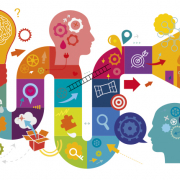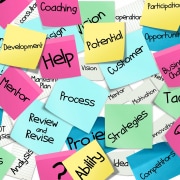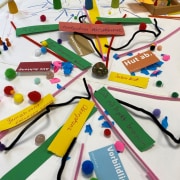Community Learning – a future learning format
03.2022
Collaboration, co-creation, lifelong learning, growth mindset – all buzzwords of our time. As different as they may seem, they are all served in community learning – a future learning format. You’ve probably heard this term before, too! But what does community learning actually mean?
Community Learning – a future learning format
Community learning describes a collaborative learning format. In informal learning groups, knowledge is acquired, exchanged, discussed, and generated online. It thrives on self-organization and the idea of community. Especially in times of remote work, this is very much in vogue. The community comes together on a provided platform and is encouraged to work on different tasks. For community learning to be successful as a supplement to your existing portfolio of training formats, it is not enough to simply create the space, but a certain degree of control is also required.
Join us on our journey!
We’ll take you on a little journey and share our best practices on the path to learning success through community! In the end, you can decide for yourself whether community learning is an overbearing evil or a future learning format for you!
1. Define target group
We start at the center of every learning journey: the participants. The target group is essential for community learning. Do the participants already know each other? Do they all have the same role or do they take different positions in the company? Is cross-team collaboration already practiced? To what extent is the group familiar with technical platforms in everyday work?
We ask ourselves these questions before planning any community learning. To achieve real added value for the participants, we try to support them in strengths. While we also challenge the group, we try not to put further stumbling blocks in their way with frameworks such as platforms or the like.
Before the group ventures to work on tasks, it is advisable to open the space for them to get to know each other. In an informal context, participants should also be able to discuss personal matters and thus lay the foundation for group cohesion and activities. If this is not possible in a face-to-face setting, platforms such as wonder.me offer a playful and easy virtual alternative.
2. Align learning content
Community learning is new, hits the zeitgeist and can achieve enormous success. But only if it is used for the right topics. Setting up a learning community for every topic or area of knowledge to be imparted will hardly lead to the desired result and will at best leave participants and organizers frustrated.
Therefore, think about the goal of your learning journey, learning unit, or work assignment beforehand and adapt the formats accordingly. If your topic is not suitable for community learning, switch to other tools, because as so often in life – it’s all in the mix!
3. Select platform
Our path to successful community learning now leads us to structure. When it comes to the question of where best to host the learner community, the simplest solution usually yields the best results. Do you already have a platform that participants are familiar with? Does your organization have a format that meets all requirements, such as privacy and security? If so, it is best to use what is already available and adapt your community learning concept if necessary. Also, focus on one platform and avoid confusion by using too many different systems. Remember, it’s all about sharing and content, the platform only creates a comfortable framework for learners.
4. Assemble the team
The success of community learning is, of course, largely dependent on the learner group. But the organizational team also plays an important role. On the one hand, it is important that the participants always talk to the same people. This group of people should be as small as possible and limited to a maximum of 2-3 team members.
On the other hand, the introduction and implementation of community learning is time-consuming and, above all, time-critical. Depending on the intensity and size of the group, it can take up to 30 minutes a day, but in most cases a few hours a week will suffice.
So, when putting together your orga team, make sure you have enough sustainability and commitment.
5. Intensive introduction
It is important to make it as easy as possible for everyone involved to get started with community learning. A comprehensive introduction to the plan and the platform for the endeavor is therefore essential. A mix of media can be used: an onboarding webinar, video tutorials, collaborative FAQs, and tips and tricks summaries can all help participants and contributors get started right where they are.
6. Tasks and Timeline
The alpha and omega of a learner community lies in structured planning. Take the time to prepare the individual posts in terms of content and timing. Important points are:
- Scope of the task: How time-intensive is the community learning task? We recommend about 15-60 minutes of effort per task. More intensive sessions should therefore fall during times when the learning journey requires less input from participants* (e.g., when there are no (virtual) workshops). Also consider the organization’s annual cycle (e.g., year-end business vs. summer slump).
- Distance between tasks: Don’t overload your group with too many tasks in too short a time. Instead, leave space for participants to be active themselves and share insights or interesting articles.
- Flexibility: Having a plan is important. However, you should not stick to it at all costs. Is there a hot topic in your organization right now? Take it up in the community! The annual employee talks are coming up? Give your community task even more practical relevance and enrich the work that the participants do in your role with a nugget from your learning journey!
7. Use media correctly
As in most fields, variety is the key to success! We’ve had good experience varying the media we use to populate our community learning platform. It’s always best to keep in mind what the goal of the message is: want to put out bundled information about an event? It’s best to use a written post for that. Want to do a little temperature check with your group? How about a video? Want to put out a teaser on a new topic? Why not try a podcast?
In the same way, participants* are also encouraged to use different media and formats. You can also encourage them to be creative in potential tasks that you want to intersperse.
8. Interaction
Interaction is the most important component for the success of community learning. This means interaction between the organizational team and the group as well as between the participants.
Community learning – a future learning format – thrives on collaboration, communication, and discussion in interaction.
Therefore, consciously plan time to not only follow what is happening on your platform, but also to like and comment. Ask (back) questions and get the conversation going should it stagnate. This may sound like a lot of work, but in the age of social media, it’s easy to do and adds value for the learner group.
9. Praise and criticism
Before we end our journey, let’s talk about feedback. Feedback is a valuable community learning tool. Coupled with direct approach, this is where we have had the greatest success.
If you notice that activity in the Learner Group is declining, it’s helpful to ask openly and casually where the community stands right now, what’s going on, and if there’s a specific reason for declining contributions. This can also be combined with a call for more participation. So you give feedback, but at the same time you ask for it.
Another approach is to positively highlight particularly active participants and thank them for their commitment to the group as a whole. We were surprised how motivating this was not only for the participants who received the positive feedback, but also for the rest of the group.
So give it a try and see what works best for your target group!
10. Celebrate successes/milestones
The last stop on our journey to successful community learning takes us to a particularly pleasant point: celebrating successes. Celebrate even small milestones with your group, such as a successful (virtual) workshop, the conclusion of an intensive phase in day-to-day business, or the end of a learning segment. Be surprised by how much positive energy, team spirit and motivation result from these small moments!
Our conclusion
That was the road to the successful implementation of community learning. It was sometimes steep and rocky. It required planning as well as flexibility and an investment of time and brainpower. But the outlook was well worth the journey: We look back on a sustainable learning experience, an expanded network and a group that has found joy in further development and exchange. For us, community learning is clearly a future learning format!
What do you think? Would you like to integrate community learning as a format into your organization? Feel free to contact us at office@tcjg.de for assistance!
This case was written by Victoria Durner.








